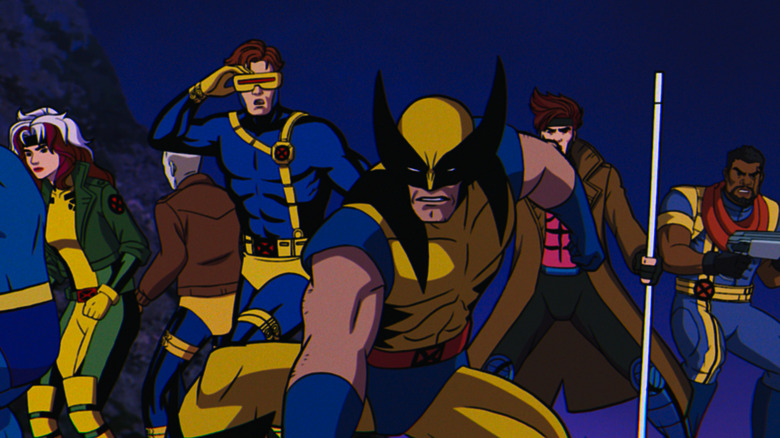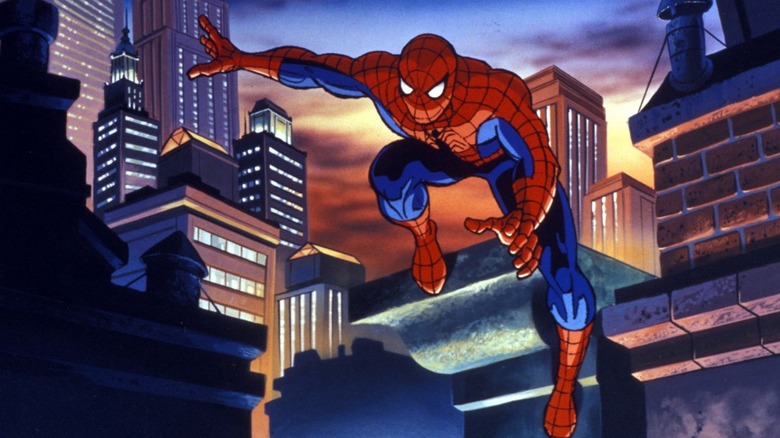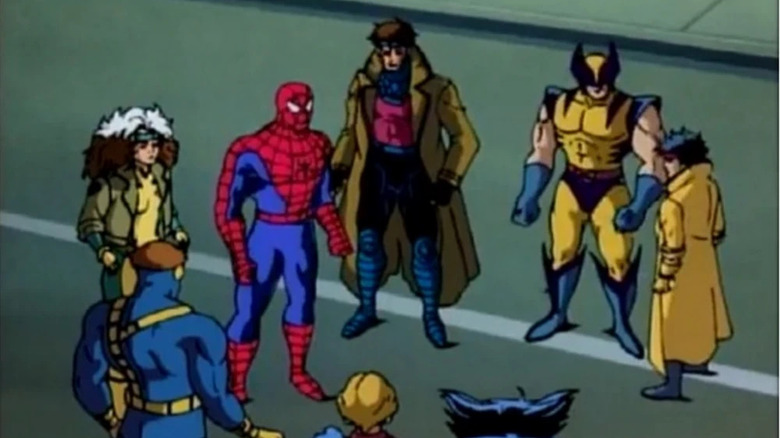X-Men '97 Features A Spider-Man Easter Egg You May Have Missed
In the first episode of "X-Men '97," the 2024 continuation of the 30-year-old "X-Men: The Animated Series," Cyclops (Ray Chase) and several other X-Men break into a warehouse occupied by a well-armed militia of bigots, keen on murdering mutants. The bigots are armed with fist-mounted laser cannons extrapolated from Sentinel technology. As X-Men fans know, Sentinels are 30-foot purple robots programmed to capture and/or kill mutants. Cyclops, using his powerful optic blasts, rescues a mutant called Robert da Costa (Gui Agustini), but he's then captured by the bigots. They remove Cyclops' visor, likely not knowing that it's needed to keep his eyeball powers under control. Cyclops merely blasts his way out, sans visor, winning the day.
There is then a brief edit to the warehouse's exterior, where the above action occurred. A newspaper floats by the camera, highlighting a mutant fashion show. It will take sharp eyes to see it, but one might see that the newspaper comes from the Daily Bugle, the newspaper heavily featured in Spider-Man comics. The Bugle also boasts smaller headlines: "Is Spider-Man a Mutant?" and "Hellfire Gala" with pictures by Peter Parker and text by Eddie Brock. It's a little fistful of Spider-Man references in an X-Men show, implying that Spider-Man may be lurking off-camera somewhere nearby.
This is not just another cute little wink-and-nod connecting two superheroes — which has long been the bread-and-butter of the Marvel Cinematic Universe — but a likely nod to "Spider-Man," the animated series that ran concurrently with "X-Men" back in the 1990s ... and even crossed over with on a few occasions. Millennial kids who were watching "X-Men" around 1995 were likely watching the "Spider-Man" series as well, so the connection between the two is strong.
Spider-Man: The Animated Series
"Spider-Man" debuted in November of 1994, two years after "X-Men" premiered. "Spider-Man" was slightly more stylized than "X-Men," giving the show its own unique look; "X-Men," by contrast, took the bulk of its designs almost directly from Jim Lee-drawn X-Men titles of the early '90s. The 1990s were a good time for animated TV superheroes. In addition to "Spider-Man" and "X-Men," there was a short-lived "Fantastic Four" animated series, which was paired with "Iron Man" as part of "The Marvel Action Hour." That was in 1994. 1996 saw a forgotten "Incredible Hulk" series on the UPN, and there was a "Silver Surfer" animated series in 1998. Incidentally, the "Silver Surfer" show was written by old "Star Trek" writers, and it was the best of the lot. This is what Marvel was doing instead of pursuing feature films at the time; Marvel wasn't yet hip enough for movies.
"Spider-Man," like "X-Men," endeavored to translate established comic book stories to the small screen, bustling through major Marvel storylines with brisk, Saturday morning efficiency. Both "Spider-Man" and "X-Men" each incorporated its own panoply of characters, each intimate to their particular, cordoned-off universes. "Spider-Man" lasted until January 1998, while "X-Men" was canceled in September 1997. The two shows overlapped for most of their respective runs, and that includes an actual crossover.
In 1995, the two-part "Spider-Man" story from the episodes "The Mutant Agenda" (September 30, 1995) and "Mutants' Revenge" (October 7, 1995) found Spider-Man trekking out to the X-Mansion, thinking he could ask someone who lived there about the mutations that Dr. Curt Connors (aka Lizard) had been going through. He didn't expect to find a super-team living there. This leads to a scene wherein Spider-Man fights Sentinels in the X-Men's holographic Danger Room.
Spider-Man meet the X-Men
Spider-Man talks to Professor X about the potential to stop mutations. When the Professor says he can't help, Spider-Man leaves the X-Men behind to get on with his own story. This will, however, lead to deeper intrigue about a villain kidnapping the X-Men member Beast and using his DNA to create a mutant-killing gene. The heroes will eventually team up, and, in so doing, bond as heroes.
The X-Men's visit to "Spider-Man" was also preceded by a Spider-Man cameo in "X-Men," although its circumstances were a little legally dodgy. In the "X-Men" episode "The Phoenix Saga, Part V: Child of Light" (September 9, 1994), there was a scene of global cataclysm wherein previously unseen superheroes stepped in to help. Spider-Man wasn't fully on camera, but audiences saw his hand enter the frame and "thwip" out a strand of webbing. According to a 2022 CBR article, the makers of "X-Men" skirted around any legal problems by classifying Spider-Man's hand as "Mutant Hands" on the design sheets. It seems the "X-Men" animators didn't get permission for their cameo. Their subterfuge snuck Spider-Man past executives.
But now the question must be asked. Is the above-described newspaper in "X-Men '97" a definite declaration of things to come? Are the makers of "X-Men '97" hinting at another crossover with the 1994 version of Spider-Man?
I would hazard to say: probably not. It's likely just a cute wink to fans; an acknowledgment that, yes, there is a Spider-Man in this universe, and, yes, the X-Men know him. It's merely likely, though, that audiences won't see him in "X-Men '97."
And to answer the Bugle's question: no, Spider-Man is not a mutant.


